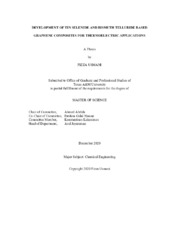| dc.description.abstract | Thermoelectric (TE) materials convert thermal energy into electrical energy, and vice versa. Bismuth telluride (Bi2Te3) is a widely studied thermoelectric material with a high figure-of-merit. Moreover, tin (IV) selenide (SnSe2) has recently attracted attention as thermoelectric material due to its predicted excellent TE properties and high performance. Nevertheless, to enable the commercialization of such thermoelectric materials, further improvement in TE performance is required. Nanocompositing is an excellent approach to enhances the properties of TE materials. Graphene is an excellent filler for nanocomposites due to its excellent electrical, thermal, and mechanical properties. In this thesis, pure Bi2Te3 and SnSe2 and their graphene nanocomposites were synthesized using hydrothermal and solvothermal solution-based methods. Detailed analysis of the chemical composition, the structural morphology, the mechanical and thermal properties, and thermal conductivity of the synthesized thermoelectric materials and their graphene nanocomposites were carried out.
The successful synthesis of SnSe2 and Bi2Te3 was confirmed by XRD and XPS analyses. The nanosize of SnSe2 with confirmed by XRD and found to ~ 31.5 nm. The incorporation of graphene into the structure of SnSe2 has improved the mechanical properties of the nanocomposites and decreased the already low thermal conductivity of pure SnSe2 (0.60 W/m.K) to 0.41 W/m.K, corresponding to a 31.7% reduction with 0.5 wt.% graphene. This decrease in thermal conductivity is expected to enhance the TE properties of SnSe2.
On the other hand, Bi2Te3 and Bi2Te3-graphene nanocomposites were also successfully synthesized. The powders were found to have good thermal stability, as evident by the TGA and DSC. The calculated average crystallite size for Bi2Te3 was 33 nm. The addition of graphene reduced the grain size of the nanopowders. Our results show that the addition of graphene to these systems can be a promising method of improving the thermoelectric performance of the materials, and the improvement of mechanical properties may aid in device fabrication for commercial applications. | en |


